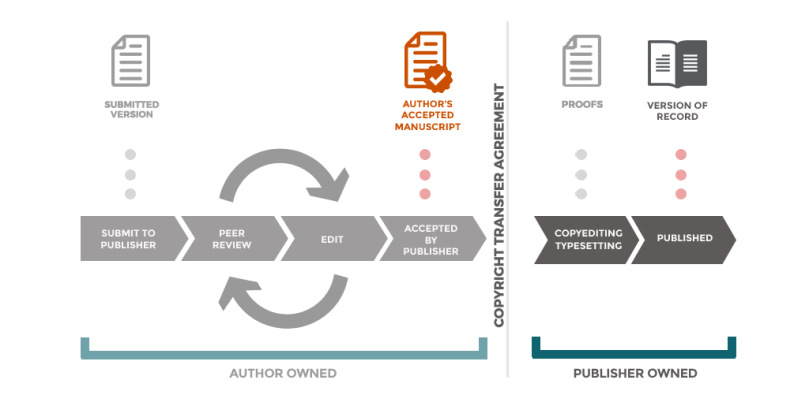In this blog post, qBionano’s Mattias discusses a potential path for publishers based at non-profit, scholarly societies towards quickly and easily becoming compatible with Plan S. Today’s blog post is a follow-up from an earlier blog post here on qBionano.
Since the announcement of Plan S two months ago, there has been vibrant discussion around potential routes towards Plan S compliance. A good summary was prepared by Jeroen Bosman & Bianca Kramer (see image below).

Recently, Robert-Jan Smits (the Open Access Envoy of the European Commission) confirmed at the OASPA conference that what is listed as “option G” in the image above (“archiving AAM on publication”) is indeed compliant with Plan S. This option has also been called the “Royal Society option” as Royal Society’s journals are already Plan S-ready.
In Royal Society’s license to publish it is stated:
You retain copyright in the Article. However, You authorise Us to act on Your behalf to defend Your copyright in the Article should anyone infringe it, and to retain half of any damages awarded after deducting Our costs.
This means that one of the key pillars of Plan S — that the authors retain copyright — is fulfilled. This also aligns well with the 70+ US-based institutions who have adopted the “Harvard open access license” (in which authors retain the rights to their work) and the ongoing effort around the UK Scholarly Communications License.
A second pillar of Plan S is that research must be made openly available upon publication without any embargo. Royal Society journals allow this as well. Authors are allowed to self-archive (e.g. through their institutional repository) their AAM (i.e. author accepted manuscript, see image below) without any embargo (known as the ‘green open access’ option).

For example, see this Sherpa page for one of the Royal Society’s subscription journals summarizing that “author can archive post-print (ie final draft post-refereeing)” and that no embargo is needed.
Royal Society publishing thus fulfills the key Plan S requirements of (i) author retaining copyright and (ii) zero embargo.
These policies (author retaining copyright and zero embargo) all scholarly societies with journals could adopt quickly and easily to become Plan S-ready, with minimal or no disruption to their journals.
While this makes journals Plan S-ready, it doesn’t solve all broader challenges. For example, there is still much work to do to ensure that the research itself (and not the journal names of where it is published) is the main focus when evaluating researchers, as we have recently discussed. This also aligns well with our recent efforts with Plaudit — an open method for sharing research recommendations. I have also previously argued that a re-alignment of the business models of some publishers would make them more valuable members of the research community, and help address the controversy surrounding the high profit margins of some for-profit publishers.
Nevertheless, I believe universal copyright retention by authors and broad adoption of zero embargo, green open access would represent a substantial advance for the research community, and I encourage all journals that are not yet Plan S-ready to consider adopting the “Royal Society model”!
Update 2018-11-05:Today the Wellcome Trust and the Gates Foundation announced that they are joining Plan S. The full policy is here and it comes with a very useful FAQ for commonly asked questions. This is the first ‘blueprint’ for how Plan S can be implemented and — encouragingly — they embrace the Royal Society model, see quote below. This provides a clear path forward for all scholarly societies to easily become Plan S-ready!
How do I comply with the policy? There are two ways to comply.
1. Publish the research article in a fully OA journal or platform. For example, this could be in eLife or journals published by PLOS, Hindawi as well as our own publishing platform, Wellcome Open Research. These journals or platforms will deposit the final, peer reviewed version of record directly into PubMed Central and publish all articles under a CC-BY licence. We will cover any reasonable publication costs charged by fully OA journals and platforms that provide these services
2. Publish the research article in any subscription journal that allows researchers to
- self-archive the Accepted Author Manuscript (AAM) in Europe PMC at the time of publication (no embargo is permitted), and
- specify that this work is available under the CC-BY licence.
An example of a publisher with subscription journals that supports this model is the Royal Society.
Update 2018-11-27: Official guidance on the implementation of Plan S has now been published and is available here.
Note: I have no affiliation with the Royal Society, I merely like that the oldest publishing scholarly society is also helping to provide leadership on this important topic. There are also other publishing scholarly societies that are already Plan S-ready.
This blog post is published under a CC BY license. The photo of the Royal Society entrance was taken by Tom Morris and is used under a CC BY-SA license.


[…] 2018-11-02: A new blog post on this topic here on qBionano is now […]
LikeLike
[…] – The Royal Society path to Plan S readiness (added 9 […]
LikeLike
[…] Open infrastructure must be supported. Researchers should never be restricted from reading or publishing research due to an inability to pay. The long-term goal should therefore be to have open infrastructure where there are zero author-facing fees and zero reader-facing fees. This is sometimes called platinum or diamond open access and is something I have discussed previously. Funders and publishers can take a leading role here by directly negotiating and establishing agreements that support open publishing infrastructure for the long term. In the short term, any and all publishers can embrace open science by simply following the “Royal Society-model” to Plan S readiness: i.e., zero embargo, green open access. […]
LikeLike
[…] – The Royal Society path to Plan S readiness (published 2 […]
LikeLike